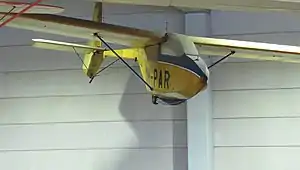PIK-5
The PIK-5 was a training glider produced in Finland in the 1940s, and 1950s,[1] equipping the country's gliding clubs with an aircraft greater in performance than primary gliders but less than competition sailplanes.[2]
| PIK-5 | |
|---|---|
 | |
| PIK-5b in Finnish Aviation Museum | |
| Role | Training glider |
| National origin | Finland |
| Manufacturer | Polyteknikkojen Ilmailukerho |
| Designer | Kaarlo J. Temmes |
| First flight | September 1946 |
| Number built | 34 |
The PIK-5 had a pod-and-boom configuration, with a high, strut-braced monoplane wing and a cruciform tail carried at the end of a tail boom that extended from a position high on the aft end of the pod.[3]
History
The prototype first flew in September 1946,[4] and testing continued until it was badly damaged in a crash in summer 1948[5] Over the subsequent months, the wings were repaired, and a new fuselage constructed to a revised design. This was completed the following winter, and flights recommenced.[5] However, this aircraft, now known as the PIK-5B, was destroyed in a crash in summer 1951.[5]
Again, it was rebuilt with modifications, particularly to the wing structure, resulting in the PIK-5C version.[5] This version first flew on 5 July 1952,[5] and went on to become the pattern for around 30 similar machines that would be built over the ensuing years.[4]
Variants
- PIK-5
- PIK 5A
- PIK-5B
- PIK-5C
Specifications (PIK-5C)
Data from Karhulan Ilmailukerho website : PIK-5c Cumulus (OH-151),[6] The World's Sailplanes:Die Segelflugzeuge der Welt:Les Planeurs du Monde Volume II[7]
General characteristics
- Crew: 1
- Length: 6.4 m (21 ft 0 in)
- Wingspan: 12.4 m (40 ft 8 in)
- Wing area: 14.7 m2 (158 sq ft)
- Aspect ratio: 10.4
- Airfoil: Göttingen 533
- Empty weight: 120 kg (265 lb)
- Max takeoff weight: 210 kg (463 lb)
Performance
- Stall speed: 45 km/h (28 mph, 24 kn)
- Never exceed speed: 190 km/h (120 mph, 100 kn)
- Rough air speed max: 120 km/h (74.6 mph; 64.8 kn)
- Aerotow speed: 20 km/h (12.4 mph; 10.8 kn)
- Winch launch speed: 90 km/h (55.9 mph; 48.6 kn)
- Terminal velocity: with full air-brakes at max all-up weight 180 km/h (112 mph; 97 kn)
- g limits: +4 -2
- Maximum glide ratio: 18 at 60 km/h (37.3 mph; 32.4 kn)
- Rate of sink: 0.85 m/s (167 ft/min) at 52 km/h (32.3 mph; 28.1 kn)
- Wing loading: 14.3 kg/m2 (2.9 lb/sq ft)
Notes
- Taylor 1989, p.726
- Hardy 1982, p.74
- "PIK-sarjan lentokoneet"
- "PIK-5c Cumulus (OH-151)"
- Tiusanen 1952, P.12
- "PIK-5c Cumulus (OH-151)". Karhulan Ilmailukerho website. Retrieved 2009-01-09.
- Shenstone, B.S.; K.G. Wilkinson (1963). The World's Sailplanes:Die Segelflugzeuge der Welt:Les Planeurs du Monde Volume II (in English, French, and German) (1st ed.). Zurich: Organisation Scientifique et Technique Internationale du Vol a Voile (OSTIV) and Schweizer Aero-Revue. pp. 180–191.
References
- Shenstone, B.S.; K.G. Wilkinson (1963). The World's Sailplanes:Die Segelflugzeuge der Welt:Les Planeurs du Monde Volume II (in English, French, and German) (1st ed.). Zurich: Organisation Scientifique et Technique Internationale du Vol a Voile (OSTIV) and Schweizer Aero-Revue. pp. 180–191.
- Hardy, Michael (1982). Gliders and Sailplanes of the World. Shepperton: Ian Allan.
- "PIK-5c Cumulus (OH-151)". Karhulan Ilmailukerho website. Retrieved 2009-01-09.
- "PIK-sarjan lentokoneet". Polyteknikkojen Ilmailukerho website. Retrieved 2009-01-08.
- Taylor, Michael J. H. (1989). Jane's Encyclopedia of Aviation. London: Studio Editions.
- Tiusanen, Keijo (1952). "PIK-5c". Ilmailu (9): 12.